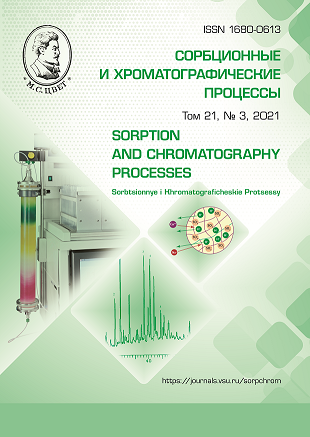Sorption concentration of phenols from aqueous media by magnetic molecular imprinted polymers based on N-vinylpyrrolidone
Abstract
Phenols are one of the most extensive groups of priority organic pollutants with mutagenic and carcinogenic properties. They are characterized by very low maximum permissible concentrations, which are difficult to determine by many modern physicochemical methods without preliminary concentration. The solution to this problem is achieved by modern approaches to solid-phase concentration, in particular, by using molecularly imprinted polymer sorbents with magnetic properties. The possibility of obtaining a magnetic sorbent based on a molecularly imprinted polymer has been studied, where N-vinylpyrrolidone was used as a functional monomer, ethylene glycol dimethacrylate was used as a crosslinking agent, and phenols were used as templates.
Nine MIPs were synthesized with imprints of 2-chlorophenol, 4-chlorophenol, 2-nitrophenol, 4-nitrophenol, bisphenol A, n-tert-butylphenol, nonylphenol, tert-nonylphenol and 4-octylphenol and polymer without molecular imprints. The particle size of the obtained polymers was about 100 nm, the saturation magnetization was 51 - 53 emu/g. The highest imprinting factors (IF) were achieved for MIPs with imprints of 4-nitrophenol (IF=3.8) and bisphenol A (IF=7.1), the lowest imprinting factors were obtained for polymers with chlorophenol imprints (IF=1.1). It was found that phenols were most efficiently sorbed at pH 3. The highest values of the selectivity coefficients were achieved upon sorption on MIP-4NP and MIP-BPA. The effectiveness of the extraction of MIP phenols ranged from 69 to 96%, for 2-NP it was not higher than 45%; on an unimprinted polymer, the effectiveness of extraction for most phenols was significantly lower.
Downloads
References
Zheng J., Chen B., Thanyamanta W., Hawboldt K. et al., Mar. Pollut. Bull, 2016, Vol. 104, pp. 7-19.
doi: 10.1016/ j.marpolbul.2016.01.004
Bakke T., Klungsøyr J., Sanni S., Mar. Environ. Res, 2013, Vol. 92, pp. 154-169.
doi: 10.1016/j. marenvres.2013.09.012.
GN 2.1.5.1315-03 (Hygienic Regula-tions) (2020) Maximum permissible concen-trations of chemical substances in waters for general and drinking purposes (in Russian).
Order (2016) The Order of Ministry of Agriculture of the Russian Federation (No 552, 13.12.2016) "Approval of water quality standards for water bodies of fishery value including the standards of maximum permis-sible concentrations of harmful substances in the waters of water bodies of fishery value (as amended on October 12, 2018)" (in Rus-sian).
SanPiN 2.1.4.1074-01 (Sanitary Rules and Regulations) (2020) Drinking water. Hy-gienic requirements for water quality. Quali-ty control. Hygienic requirements for hot water systems safety (in Russian).
Rodríguez I., Llompart M.P., Cela R., J. Chromatogr. A, 2000, Vol. 885, pp. 291-304.
doi: 10.1016/S0021-9673(00) 00116-3.
Bagheri H., Mohammadi A., Salemi A., Anal. Chim. Acta, 2004, Vol. 513, pp. 445-449.
doi: 10.1016/j.aca.2004.03.020.
Prieto A., Araujo L., Navalon A., Vilchez J., Curr. Anal. Chem, 2010, Vol. 5, pp. 219-224.
doi: 10.2174/157341109788680309.
Turiel E., Martín-Esteban A., TrAC Trends Anal. Chem, 2019, Vol. 118, pp. 574-586.
doi: 10.1016/j.trac.2019.06.016.
Surikumaran H., Mohamad S., Mu-hamad Sarih N., Muggundha Raoov., Separ. Sci. Technol, 2015, Vol. 6395, pp. 2342-235. doi: 10.1080/01496395.2015.1043016.
El-Sheikh A.H., Al-Quse R.W., El-Barghouthi M.I., Al-Masri F.S., Talanta, 2010. Vol. 83, pp. 667-673.
doi: 10.1016/j. talanta.2010.10.022.
Caro E., Marc´e R.M., Cormack P.G., Sherrington D.C. et al., J. Chromatogr. A, 2003, Vol. 995, pp. 233-238.
doi: 10.1016/S0021-9673(03)00543-0.
Feng Q.-Z., Zhao L.-X., Yan W., Lin J.-M. et al., J. Hazard. Mater., 2009. Vol. 167, pp 282-288.
doi: 10.1016/j.jhazmat.2008.12.115.
Gryshchenko A.O., Bottaro C.S., Int. J. Mol. Sci., 2014, Vol. 15, pp. 1338-1357. doi: 10.3390/ijms15011338.
Zhao Q., Lu Q., Feng Y.Q., Anal. Bio-anal. Chem., 2013, Vol. 405, pp. 4765-4776. doi: 10.1007/s00216-013-6866-5.
Xu Z., Ding L., Long Y.J., Xu L.G. et al., Anal. Methods, 2011, Vol. 3, pp. 1737-1744. doi: 10.1039/C1AY05206C.
Wu X.Q., Wang X.Y., Lu W.H., Wang X.R. et al., J. Chromatogr. A, 2016, Vol. 1435, pp.30-38.
doi: 10.1016/j.chroma.2016.01.040.
Li F., Cai C.C., Cheng J., Zhou H.B. et al., Microchim. Acta, 2015, Vol. 182, pp. 2503-2511.
doi: 10.1007/s00604-015-1619-0.
Xiao D.L., Lu T., Zeng R., Bi Y.P., Mi-crochim. Acta, 2016, Vol. 183, pp. 2655-2675.
doi: 10.1007/s00604-016-1928-y.
Gubin A.S., Sukhanov P.T., Kushnir A.A., Proskuryakova E.D., Russ. J. Appl. Chem., 2018, Vol. 91, pp. 1626-1634. doi: 10.1134S1070427218100099.
Gubin A.S., Sukhanov P.T., Sannikova N.Y., Proskuryakova E.D. et al., J. Anal. Chem., 2019, Vol. 74, Suppl. 1, pp. S11-S17. doi:10.1134/s1061934819070116.
Churilina E.V., Sukhanov P.T., Ermak S.S., Korenman Ya.I. et al., J. Analyt. Chem., 2012, Vol. 67, No 9, pp 767-771. doi: 10.1134/S1061934812050048.
Silva V.A.J., Andrade P.L., Silva M.P.C., Bustamante D.A., et al., Journal of Magnetism and Magnetic Materials, 2013, Vol. 343. pp. 138-143. doi: 10.1016/j.jmmm.2013.04.062.
Ji Y., Yin J., Xu Z., Zhao C. et al., Anal. Bioanal. Chem., 2009, Vol. 395, pp. 1125-1133.
doi: 10.1007/s00216-009-3020-5







